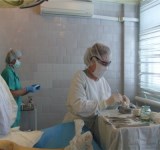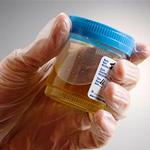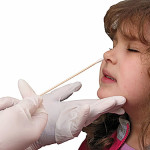 Clinical blood test
Clinical blood test
Most often in medical practice, a clinical blood test for diagnostic purposes. A general clinical blood test includes a qualitative and quantitative study of blood cells, which include:
- erythrocytes;
- platelets;
- leukocytes;
- amount of hemoglobin;
- erythrocyte sedimentation rate (ESR).
Changes in the cellular composition indicate the presence of pathological processes in the human body.
Taking blood for a clinical study
Blood for a clinical study is taken from the patient in the morning, on an empty stomach, from the capillaries of the finger by puncturing it with a scarifier. Less commonly, blood is taken from a vein. The nurse writes out a referral for a blood test on a special form of accounting form f No. 45.
Most often, blood is taken from the IV finger of the left or right hand. Previously, the skin is treated with an antiseptic (70% alcohol, a mixture of 70% alcohol with chlorhexidine, etc.). A puncture with a scarifier needle is made into the pulp of the first phalanx of the finger, from the side to a depth of about 3 mm. After the puncture, blood should flow freely. With a strong compression of the finger, an intercellular substance is mixed with it to improve the release of blood, which reduces the reliability of the result of the study.
red blood cells
Red blood cells are the components of blood that contain hemoglobin. Their main function is to transport oxygen and carbon dioxide. The number of erythrocytes is determined in a counting chamber.
Approximate norms for the content of red blood cells in human blood:
- Children: 3.7 - 5.0 • 10 12 / l.
- Women: 3.5 - 5.2 • 10 12 / l.
- Men: 3.9 - 5.6 • 10 12 / l.
An increase in the number of red blood cells - erythrocytosis - may indicate a lack of oxygen in the tissues of the body with the following pathologies:
- heart defects;
- emphysema;
- cor pulmonale;
- frequent stay at high altitudes.
Reactive erythrocytosis occurs in the following cases:
- neoplasms;
- polycystic kidney disease;
- dropsy of the renal pelvis;
- Cushing's disease and syndrome;
- treatment with steroid drugs.
A decrease in the number of red blood cells in the blood - erythropenia - is observed when:
- anemia;
- acute blood loss;
- hyperhydration;
- in late pregnancy.
Hemoglobin
The main component of red blood cells - hemoglobin - an iron-containing protein, is responsible for supplying oxygen to organs and tissues, more precisely, for transporting it to them. Norm of hemoglobin content:
- Children depending on age: significant fluctuations - from 105 to 160 g / l.
- Women: 120 - 140 g / l.
- Men: 130 - 160 g / l.
An increase in the concentration of hemoglobin in the blood indicates primary or secondary erythremia or dehydration.
A decrease in hemoglobin indicates anemia or overhydration.
Anemia can be different, and their diagnosis requires extensive clinical and additional biochemical and hematological blood tests.
Leukocytes
Blood cells that are produced in the bone marrow and lymph nodes. Normally, the composition of peripheral blood provides for the presence of 5 types of leukocytes:
- eosinophils, basophils, neutrophils - granulocytes;
- monocytes;
- lymphocytes.
The general main function of leukocytes is to protect the body from foreign substances. But each type of leukocyte is independent and performs its own independent function. Together, the activity of all leukocytes is a single system.
An increase in the number of leukocytes in the blood - leukocytosis - is a response of the body to the introduction of a foreign agent or to the activation of opportunistic flora inside the body. Leukocytosis may be characterized by an increase in one or more types of white blood cells. Physiological leukocytosis is observed after eating, or after exercise, during pregnancy.
A decrease in the content of the number of leukocytes - leukopenia - is caused by a drop in the number of neutrophils, lymphocytes, or all types of leukocytes.
The norm of the content of leukocytes in the blood:
- 4-9 • 109/l.
An increase in the number of leukocytes is observed in the following conditions:
- infectious diseases of bacterial, viral, fungal etiology;
- acute inflammatory and purulent processes;
- malignant neoplasms;
- traumatic tissue damage;
- myocardial infarction;
- leukemia;
- uremia;
- action of adrenaline and steroids.
Leukopenia accompanies such pathological conditions as:
- aplasia and hypoplasia of the bone marrow;
- impact on the bone marrow of ionizing radiation, chemotherapy drugs;
- acute leukemia;
- myelodysplastic syndromes;
- collagenoses;
- primary and secondary hypersplenism;
- myelofibrosis;
- plasmacytoma;
- tumor metastases in the bone marrow;
- pernicious anemia;
- anaphylactic shock;
- typhus and paratyphoid;
- viral diseases.
The percentage of different types of leukocytes is called the leukocyte formula and is determined in a stained blood smear.
Erythrocyte sedimentation rate (ESR)
The erythrocyte sedimentation rate is the so-called non-specific indicator of the inflammatory process in the body. ESR control is often used to track the dynamics of the disease.
Normal ESR values depending on age:
- for newborns: from 0 to 2 mm/hour;
- infants 0 to 6 months: 12-17 mm/hour;
- women under 60: 6-15 mm/hour;
- men under 60: 4-12 mm/hour
- women and men over 60: 15-20 mm/hour.
ESR acceleration accompanies the following processes:
- menstruation, pregnancy, postpartum period;
- inflammatory processes associated with infections, injuries, autoimmune diseases, as well as shock, surgery, lead and arsenic poisoning;
- anemia;
- thyroid dysfunction (hypo- and hyperthyroidism);
- oncological diseases;
- damage to the kidneys, liver, endocrine disorders.
ESR is slowed down in the following pathological conditions:
- hyperbilirubinemia;
- hypofibrinogenemia;
- chronic circulatory failure;
- reactive erythrocytosis and erythremia.
A more detailed clinical blood test includes determining the color index, counting all types of leukocytes, as well as platelets and plasma cells.





